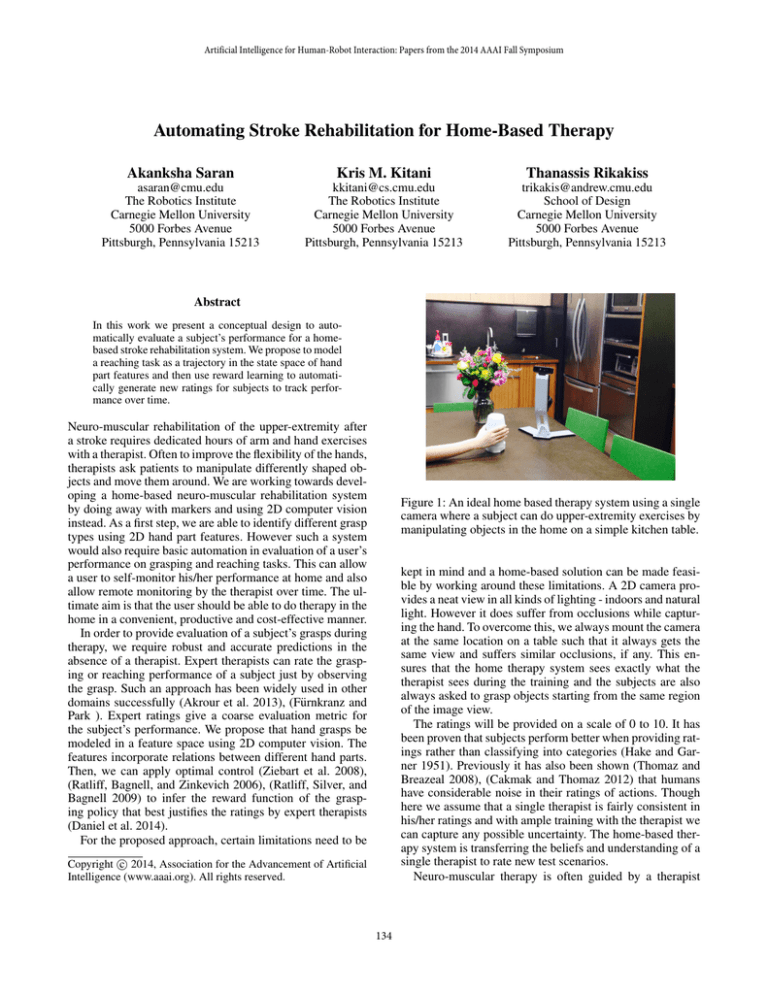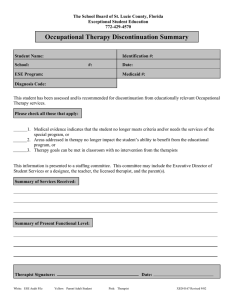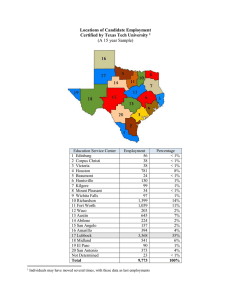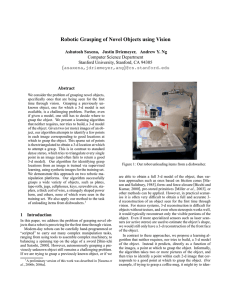
Artificial Intelligence for Human-Robot Interaction: Papers from the 2014 AAAI Fall Symposium
Automating Stroke Rehabilitation for Home-Based Therapy
Akanksha Saran
Kris M. Kitani
Thanassis Rikakiss
asaran@cmu.edu
The Robotics Institute
Carnegie Mellon University
5000 Forbes Avenue
Pittsburgh, Pennsylvania 15213
kkitani@cs.cmu.edu
The Robotics Institute
Carnegie Mellon University
5000 Forbes Avenue
Pittsburgh, Pennsylvania 15213
trikakis@andrew.cmu.edu
School of Design
Carnegie Mellon University
5000 Forbes Avenue
Pittsburgh, Pennsylvania 15213
Abstract
In this work we present a conceptual design to automatically evaluate a subject’s performance for a homebased stroke rehabilitation system. We propose to model
a reaching task as a trajectory in the state space of hand
part features and then use reward learning to automatically generate new ratings for subjects to track performance over time.
Neuro-muscular rehabilitation of the upper-extremity after
a stroke requires dedicated hours of arm and hand exercises
with a therapist. Often to improve the flexibility of the hands,
therapists ask patients to manipulate differently shaped objects and move them around. We are working towards developing a home-based neuro-muscular rehabilitation system
by doing away with markers and using 2D computer vision
instead. As a first step, we are able to identify different grasp
types using 2D hand part features. However such a system
would also require basic automation in evaluation of a user’s
performance on grasping and reaching tasks. This can allow
a user to self-monitor his/her performance at home and also
allow remote monitoring by the therapist over time. The ultimate aim is that the user should be able to do therapy in the
home in a convenient, productive and cost-effective manner.
In order to provide evaluation of a subject’s grasps during
therapy, we require robust and accurate predictions in the
absence of a therapist. Expert therapists can rate the grasping or reaching performance of a subject just by observing
the grasp. Such an approach has been widely used in other
domains successfully (Akrour et al. 2013), (Fürnkranz and
Park ). Expert ratings give a coarse evaluation metric for
the subject’s performance. We propose that hand grasps be
modeled in a feature space using 2D computer vision. The
features incorporate relations between different hand parts.
Then, we can apply optimal control (Ziebart et al. 2008),
(Ratliff, Bagnell, and Zinkevich 2006), (Ratliff, Silver, and
Bagnell 2009) to infer the reward function of the grasping policy that best justifies the ratings by expert therapists
(Daniel et al. 2014).
For the proposed approach, certain limitations need to be
Figure 1: An ideal home based therapy system using a single
camera where a subject can do upper-extremity exercises by
manipulating objects in the home on a simple kitchen table.
kept in mind and a home-based solution can be made feasible by working around these limitations. A 2D camera provides a neat view in all kinds of lighting - indoors and natural
light. However it does suffer from occlusions while capturing the hand. To overcome this, we always mount the camera
at the same location on a table such that it always gets the
same view and suffers similar occlusions, if any. This ensures that the home therapy system sees exactly what the
therapist sees during the training and the subjects are also
always asked to grasp objects starting from the same region
of the image view.
The ratings will be provided on a scale of 0 to 10. It has
been proven that subjects perform better when providing ratings rather than classifying into categories (Hake and Garner 1951). Previously it has also been shown (Thomaz and
Breazeal 2008), (Cakmak and Thomaz 2012) that humans
have considerable noise in their ratings of actions. Though
here we assume that a single therapist is fairly consistent in
his/her ratings and with ample training with the therapist we
can capture any possible uncertainty. The home-based therapy system is transferring the beliefs and understanding of a
single therapist to rate new test scenarios.
Neuro-muscular therapy is often guided by a therapist
c 2014, Association for the Advancement of Artificial
Copyright Intelligence (www.aaai.org). All rights reserved.
134
(a) On the left, the subject is unable to naturally
open the clenched fingers though is able to make
contact with the cup using the thumb and index
finger. On the right, the grasp is looking more natural with all fingers grasping the mug in synergy.
Figure 2: 12 different hand parts used for capturing the components of a grasp visible from an overhead 2D camera.
The feature space of distance, mid-point, orientation and
between-pair features are defined over the set of these hand
parts.
with a highly individualized approach for each patient. However the ways of grasping an object can be clearly distinguished as bad or good grasps (Figure 3). Therapists distinguish between this broad category very well. Our approach
assumes that given enough rating samples from therapists,
the system could generalize for important classes of grasps
(range of ratings) such as very bad, bad, not too bad, good,
very good and so on.
(b) On the left, the subject is unable to open the
hand with a full aperture (inflexible) whereas on
the right the subject has a more open grasp.
2D Hand Part Features
Figure 3: Illustrations of bad and good grasps which would
achieve rating on the lower and higher side of the scale respectively by a therapist.
We use a structured output random forest (Dollár and
Zitnick 2013) with multiple levels of predictions capturing
context to effectively label hand parts for a single 2D image
(Figure 2). Once we obtain the hand parts, we can denote
every grasp as a point in the space of pair-wise features
proven to work for food recognition (Yang et al. 2010).
We randomly select 1000 pixels from the segmented hand
image (Figure 2) and generate the following set of features:
ZZZ
Es,w,τ [R(f )] =
R(f = φ(τ ))p(s, w, τ )dsdwdτ
(1)
where p(s, w, τ ) = p(τ |s, w)π(w|s)η π (s) and f is the
feature space to which an image is transformed.
• Distance features - Euclidean distance between two pixels.
• Orientation features - The angle with the positive x-axis
by the line joining the two pixels.
Our goal is to find a probabilistic model p(R|o, D) that
predicts the reward given an observed outcome and training data D, which is obtained from an expert as proven before(Daniel et al. 2014). Similarly, we couple policy search
with reward learning (modeled as a Gaussian Process). The
policy would vary for each reaching and grasping task (example grasping a mug, grasping a pen and so on).
• Midpoint features - The probability distribution of the
hand parts for the pixel which is the midpoint of the line
joining the two pixels.
• Between pair features - The part labels for all the pixels
lying on the line joining the two pixels.
Conclusion
Learning Reward
We present this as a conceptual design paper as a first step
in automation of neuro-muscular stroke rehabilitation for
a home-based therapy system, guided by computer vision.
Transforming a 2D image into a set of hand part features can
allow us to model a reaching or grasping task during therapy
as a MDP in the feature space. Ratings for these tasks from
a therapist can help the system to learn optimal policy. Once
the policy and rewards for state transitions have been learnt,
when a new subject reaches an object, the system can predict
the rating for his/her contact grasp by observing the trajectory in the vision based feature space.
The reward and policy are specific to grasping a single
object. We consider the contextual episodic policy search
with continuous states s ∈ S (representation in the pairwise hand part features) and continuous control parameters
w ∈ Ω (the hand-part distribution for an image). The distribution over states is denoted by η π (.). A trajectory τ results
from a continuous set of images (hand part segmentation images). We can initialize the policy as a single Gaussian with
random mean and update our policy to maximize the expected reward.
135
Future Work
We will test our proposed approach with real data of nonimpaired and impaired subjects with ratings available from
therapists for training and testing.
References
Akrour, R.; Schoenauer, M.; Sebag, M.; et al. 2013. Interactive robot education. In ECML/PKDD Workshop on Reinforcement Learning with Generalized Feedback: Beyond
Numeric Rewards.
Cakmak, M., and Thomaz, A. L. 2012. Designing
robot learners that ask good questions. In Proceedings of
the seventh annual ACM/IEEE international conference on
Human-Robot Interaction, 17–24. ACM.
Daniel, C.; Viering, M.; Metz, J.; Kroemer, O.; and Peters, J.
2014. Active reward learning. In Proceedings of Robotics:
Science and Systems.
Dollár, P., and Zitnick, C. L. 2013. Structured forests for
fast edge detection. In Computer Vision (ICCV), 2013 IEEE
International Conference on, 1841–1848. IEEE.
Fürnkranz, W. C. J., and Park, E. H. S.-H. Preference-based
policy iteration.
Hake, H. W., and Garner, W. 1951. The effect of presenting
various numbers of discrete steps on scale reading accuracy.
Journal of Experimental Psychology 42(5):358.
Ratliff, N. D.; Bagnell, J. A.; and Zinkevich, M. A. 2006.
Maximum margin planning. In Proceedings of the 23rd
international conference on Machine learning, 729–736.
ACM.
Ratliff, N. D.; Silver, D.; and Bagnell, J. A. 2009. Learning to search: Functional gradient techniques for imitation
learning. Autonomous Robots 27(1):25–53.
Thomaz, A. L., and Breazeal, C. 2008. Teachable robots:
Understanding human teaching behavior to build more effective robot learners. Artificial Intelligence 172(6):716–
737.
Yang, S.; Chen, M.; Pomerleau, D.; and Sukthankar, R.
2010. Food recognition using statistics of pairwise local features. In Computer Vision and Pattern Recognition (CVPR),
2010 IEEE Conference on, 2249–2256. IEEE.
Ziebart, B. D.; Maas, A. L.; Bagnell, J. A.; and Dey, A. K.
2008. Maximum entropy inverse reinforcement learning. In
AAAI, 1433–1438.
136










